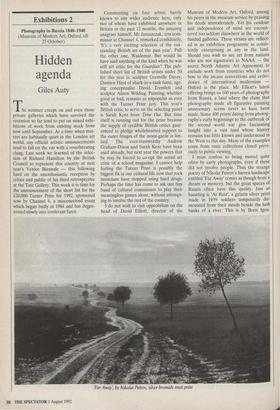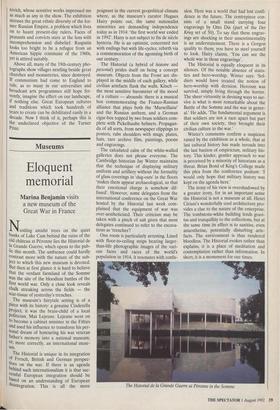Exhibitions 2
Photography in Russia 1840-1940 (Museum of Modern Art, Oxford, till 25 October)
Hidden agenda
Giles Auty
The summer creeps on and even those private galleries which have survived the recession so far tend to put on mixed exhi- bitions of work from existing stock from now until September. At a time when mat- ters are habitually quiet in the London art world, any official artistic announcements tend to fall on the ear with a reverberating clang. Last week we learned of the selec- tion of Richard Hamilton by the British Council to represent this country at next year's Venice Biennale — this following hard on the unenthusiastic reception by critics and public of his third retrospective at the Tate Gallery. This week it is time for the announcement of the short list for the £20,000 Turner Prize for 1992, sponsored now by Channel 4, a misconceived event which began badly in 1984 and has degen- erated slowly into irrelevant farce. Commenting on four artists barely known to any wider audience here, only two of whom have exhibited anywhere in Britain in the past 12 months, the amazing anagram himself, Mr Januszczak, arts com- missar at Channel 4, remarked confidently, 'It's a very exciting selection of the out- standing British art of the past year'. Pull the other one, Waldemar. But would he have said anything of the kind when he was still art critic for the Guardian? The pub- lished short list of British artists under 50 for this year is: sculptor Grenville Davey, Damien Hirst of shark-in-a-tank fame, age- ing conceptualist David Tremlett and sculptor Alison Wilding. Painting, whether good or bad, remains as unpopular as ever with the Turner Prize jury. This year's British critic to serve on the selecting panel is Sarah Kent from Time Out. But time itself is running out for the prize because the supply of credible British critics guar- anteed to pledge wholehearted support to the outer fringes of the avant-garde is lim- ited. The ever-trustworthy Andrew Graham-Dixon and Sarah Kent have been used already, but next year the powers that be may be forced to co-opt the noted art critic of a school magazine. I cannot help feeling the Turner Prize is possibly the biggest fix in our cultural life now that rock musicians have stopped using hard drugs. Perhaps the time has come to ask our tiny band of cultural commissars to play their meaningless games alone, without attempt- ing to involve the rest of the country.
I do not wish to visit opprobrium on the head of David Elliott, director of the
Museum of Modern Art, Oxford, among his peers in the museum service by praising his deeds immoderately. Yet his candour and independence of mind are encoun- tered too seldom elsewhere in the world of funded galleries. These virtues are reflect- ed in an exhibition programme as consis- tently enterprising as any in the land. Should you wish to see art from nations who are not signatories to NAAA — the secret North Atlantic Art Agreement to exclude work from countries who do not bow to the arcane conventions and ortho- doxies of international modernism Oxford is the place. Mr Elliott's latest offering brings us 100 years of photography from Russia, a land where the claim that photography made all figurative painting unnecessary seems never to have been made. Some 400 prints dating from photog- raphy's early beginnings to the outbreak of the second world war give fascinating insight into a vast land whose history remains too little known and understood in the West to this day. Many of the examples come from state collections closed previ- ously to public viewing.
I must confess to being moved quite often by early photographs, even if these did not involve people. Thus the strange poetry of Nikolai Petrov's barren landscape entitled 'Far Away' comes as though from a dream or memory, but the great spaces of Russia often have this quality. Just as haunting is 'At Rest', a gelatin silver print made in 1939: soldiers temporarily dis- mounted from their steeds beside the lush banks of a river. This is by Boris Igna- 'Far Away, by Nikolai Petrov, silver bromide matt print tovich, whose sensitive works impressed me as much as any in the show. The exhibition stresses the great ethnic diversity of the for- mer Russian Empire, a problem which lives on to haunt present-day rulers. Faces of peasants and convicts stare at the lens with incomprehension and disbelief. Rasputin looks too bright to be a refugee from an American hippie commune of the 1960s, yet is attired suitably.
Above all, many of the 19th-century pho- tographs show villages nestling beside great churches and monasteries, since destroyed. If communism had come to England to rule, as so many in our universities and broadcast arts programmes still hope fer- vently, imagine the effect on our landscape, if nothing else. Great European cultures and traditions which took hundreds of years to create can be debilitated easily in a decade. Now I think of it, perhaps this is the undeclared objective of the Turner Prize.



















































 Previous page
Previous page